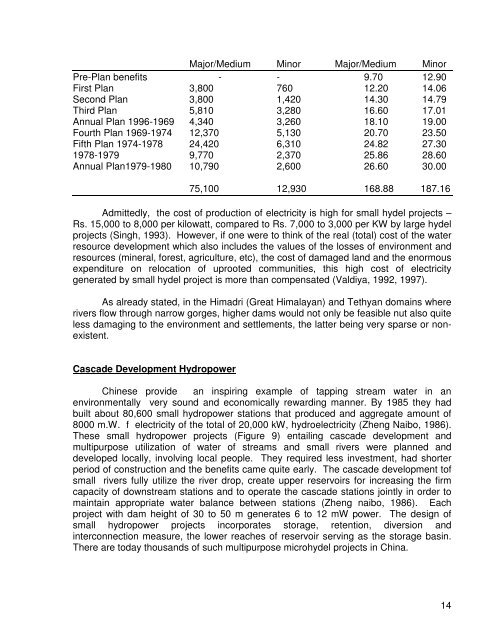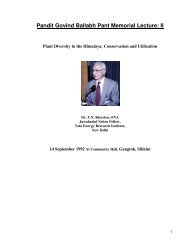PANDIT GOVIND BALLABH PANT MEMORIAL LECTURE: VII ...
PANDIT GOVIND BALLABH PANT MEMORIAL LECTURE: VII ...
PANDIT GOVIND BALLABH PANT MEMORIAL LECTURE: VII ...
You also want an ePaper? Increase the reach of your titles
YUMPU automatically turns print PDFs into web optimized ePapers that Google loves.
Major/Medium Minor Major/Medium Minor<br />
Pre-Plan benefits - - 9.70 12.90<br />
First Plan 3,800 760 12.20 14.06<br />
Second Plan 3,800 1,420 14.30 14.79<br />
Third Plan 5,810 3,280 16.60 17.01<br />
Annual Plan 1996-1969 4,340 3,260 18.10 19.00<br />
Fourth Plan 1969-1974 12,370 5,130 20.70 23.50<br />
Fifth Plan 1974-1978 24,420 6,310 24.82 27.30<br />
1978-1979 9,770 2,370 25.86 28.60<br />
Annual Plan1979-1980 10,790 2,600 26.60 30.00<br />
75,100 12,930 168.88 187.16<br />
Admittedly, the cost of production of electricity is high for small hydel projects –<br />
Rs. 15,000 to 8,000 per kilowatt, compared to Rs. 7,000 to 3,000 per KW by large hydel<br />
projects (Singh, 1993). However, if one were to think of the real (total) cost of the water<br />
resource development which also includes the values of the losses of environment and<br />
resources (mineral, forest, agriculture, etc), the cost of damaged land and the enormous<br />
expenditure on relocation of uprooted communities, this high cost of electricity<br />
generated by small hydel project is more than compensated (Valdiya, 1992, 1997).<br />
As already stated, in the Himadri (Great Himalayan) and Tethyan domains where<br />
rivers flow through narrow gorges, higher dams would not only be feasible nut also quite<br />
less damaging to the environment and settlements, the latter being very sparse or nonexistent.<br />
Cascade Development Hydropower<br />
Chinese provide an inspiring example of tapping stream water in an<br />
environmentally very sound and economically rewarding manner. By 1985 they had<br />
built about 80,600 small hydropower stations that produced and aggregate amount of<br />
8000 m.W. f electricity of the total of 20,000 kW, hydroelectricity (Zheng Naibo, 1986).<br />
These small hydropower projects (Figure 9) entailing cascade development and<br />
multipurpose utilization of water of streams and small rivers were planned and<br />
developed locally, involving local people. They required less investment, had shorter<br />
period of construction and the benefits came quite early. The cascade development tof<br />
small rivers fully utilize the river drop, create upper reservoirs for increasing the firm<br />
capacity of downstream stations and to operate the cascade stations jointly in order to<br />
maintain appropriate water balance between stations (Zheng naibo, 1986). Each<br />
project with dam height of 30 to 50 m generates 6 to 12 mW power. The design of<br />
small hydropower projects incorporates storage, retention, diversion and<br />
interconnection measure, the lower reaches of reservoir serving as the storage basin.<br />
There are today thousands of such multipurpose microhydel projects in China.<br />
14











